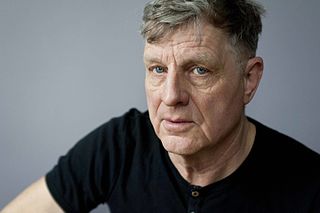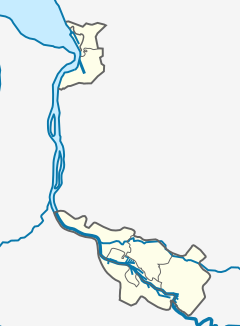
Wilhelm Wagenfeld was a German industrial designer and former student of the Bauhaus art school. He designed glass and metal works for the Jenaer Glaswerk Schott & Gen., the Vereinigte Lausitzer Glaswerke in Weißwasser, Rosenthal, Braun GmbH and WMF. Some of his designs are still produced to this day.

Bremen, officially the City Municipality of Bremen, is the capital of the German state Free Hanseatic City of Bremen, a two-city-state consisting of the cities of Bremen and Bremerhaven. With about 570,000 inhabitants, the Hanseatic city is the 11th largest city of Germany and the second largest city in Northern Germany after Hamburg.

Hans-Peter Feldmann was a German visual artist. Feldmann's approach to art-making was one of collecting, ordering, and re-presenting.

Rainer Fetting is a German painter and sculptor.
Rémy Zaugg was a Swiss painter, primarily known as a conceptual artist. He played an important role as both a critic and observer of contemporary culture, especially with regards to the perception of space and architecture.

Michael Gitlin is a contemporary sculptor.

The Archive for Small Press & Communication was founded in 1974 by Guy Schraenen and Anne Marsily in Antwerp, Belgium. It was part of the international network of the small press movements of this period. In fact the A.S.P.C. was a development of the former activities in Guy Schraenen's Galerie Kontakt (1966–1978) and their publishing house Guy Schraenen éditeur (1973–1978).

Wilhelm Wagenfeld House is a design museum and exhibition centre in Bremen, Germany. Completed in the Neoclassical style in 1828, the building now carries the name of Bremen-born Wilhelm Wagenfeld (1900–1990), a major contributor to the 20th-century design of household objects. In addition to a collection of Wagenfeld's creations, the building hosts temporary design exhibitions. It is located in Bremen's Old Town (Altstadt) close to the Kunsthalle Bremen art museum.

The Gerhard Marcks Museum or Gerhard Marcks House is a museum in Bremen, Germany, inspired by the work of the sculptor and graphic artist Gerhard Marcks. The museum exhibits contemporary sculpture, including the work of Marcks.

The Teerhof is a peninsula between the River Weser and the Kleine Weser, opposite the city centre of Bremen, Germany. It was first mentioned in 1624 as "Theerhof" when it was the northernmost part of an island. Today it consists mainly of residential buildings and the Weserburg modern art museum.

Viertel is a centrally located neighborhood in the city of Bremen, Germany. It lies east of the old town on the border between two different administrative subdistricts: Ostertor and Steintor. It is currently recognised for its many cafés, restaurants, and boutique boutiques.

The Ports of Bremen, Bremen Ports or Bremish Ports, in German "Bremische Häfen" consist of the commercial ports in Bremen and Bremerhaven. They are managed by bremenports GmbH & Co. KG, a company of private status in public property.
Peter Friese, is a German art historian and curator.

The Focke Museum is the museum of history and the history of art for the city and state of Bremen. It was formed in 1924 by the merger of a museum of industry and commerce and the previous historical museum, and is named for the founder of the latter, Johann Focke (1848–1922), a Bremen privy councillor and father of Henrich Focke. It is located in 4.5 hectares of grounds in the Riensberg neighbourhood of the city. In addition to a main building which opened in 1964 and was extended in 2002, the museum complex includes buildings dating from the 16th to the 19th centuries.

Peter Welz is a contemporary German artist based in Berlin. He has been exhibiting his work in video, sculpture and installations since 2003.
Peter Zimmermann is a German painter, sculptor, object artist and university professor.

Stephane Leonard is a German artist. Leonard works in various different media. His oeuvre spans from drawing and painting to sound installation, music, video installation, music videos and film.
Norbert Prangenberg was an abstract painter, sculptor, and engraver who was born in Nettseheim, just outside of Cologne, Germany. Though he had no formal training and did not fully engage with art until his 30s, Prangenberg did finally come up with a style that was uniquely his own, not fitting comfortably into the neo-expressionist or neo-geo movements of his time, in the 1970s and 1980s. At this time, he was considered a major figure in contemporary German art. Though he got his start with abstract paintings, he also became known for making sculptures of all sizes; and while his work initially appears abstract, the titles given sometimes allude to the human body or a landscape. As a trained gold- and silversmith, as well as a glassblower, he always showed an attention to materials and how they could be physically engaged with. He was interested in how his own two hands could affect the painting or sculpture's surface. Traces of the artist's hand appear literally throughout his entire oeuvre, before he lost the battle with liver cancer in 2012.
Frantiček Klossner is a Swiss artist based in Bern, known for creating video art, installations, performance, drawings and visual poetry.















